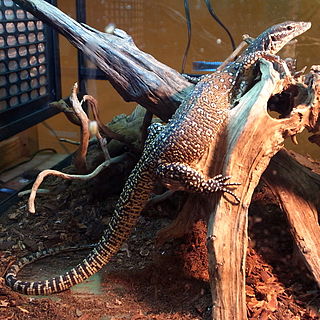
The Varanidae are a family of lizards in the superfamily Varanoidea and order Anguimorpha. The family, a group of carnivorous and frugivorous lizards, includes the living genus Varanus and a number of extinct genera more closely related to Varanus than to the earless monitor lizard (Lanthanotus). Varanus includes the Komodo dragon, crocodile monitor, savannah monitor, the goannas of Australia and Southeast Asia, and various other species with a similarly distinctive appearance. Their closest living relatives are the earless monitor lizard and Chinese crocodile lizard. The oldest members of the family are known from the Late Cretaceous of Mongolia.

Monitor lizards are lizards in the genus Varanus, the only extant genus in the family Varanidae. They are native to Africa, Asia, and Oceania, and one species is also found in the Americas as an invasive species. About 80 species are recognized.

The Asian water monitor is a large varanid lizard native to South and Southeast Asia. It is widely considered to be the second-largest lizard species, after the Komodo dragon. It is distributed from eastern and northeastern India and Bangladesh, the Andaman and Nicobar Islands, Sri Lanka, through southern China and Hainan Island in the east to mainland Southeast Asia and the islands of Sumatra, Borneo, Java, Lombok, the Riau Archipelago, Sulawesi. It is one of the most widespread monitor lizards.

The sand goanna, also known commonly as Gould's monitor, the racehorse goanna, and the sand monitor, is a species of large Australian monitor lizard in the family Varanidae.

The mangrove monitor, mangrove goanna, or Western Pacific monitor lizard is a member of the monitor lizard family with a large distribution from northern Australia and New Guinea to the Moluccas and Solomon Islands. It grows to lengths of 3.5 to 4 ft. It is also known as wbl yb in the Kalam language of Papua New Guinea.

The yellow-spotted monitor, also known as the Argus monitor, is a monitor lizard found in northern and western regions of Australia and southern New Guinea.

The rock monitor is a species of monitor lizard in the family Varanidae. The species is endemic to Sub-Saharan Africa, where, on average it is the largest lizard found on the continent. It is called leguaan or likkewaan in some areas.

The peacock monitor, also known commonly as Auffenberg's monitor, is a species of small monitor lizard in the family Varanidae. The species, which belongs to the subgenus Odatria, is endemic to Rote Island, Indonesia.

The pygmy mulga monitor, also known commonly as Gillen's monitor or just the mulga monitor, is a species of lizard in the family Varanidae. The species is endemic to Australia.

The Kimberley rock monitor is a medium-sized species of monitor lizard in the family Varanidae. The species is native to Northern Australia. Also known commonly as Glauert's monitor and the Kakadu sand goanna, it belongs to the subgenus Odatria.

The peach-throated monitor, also known as the Sepik monitor, is a species of monitor lizard native to New Guinea.
The black-spotted ridge-tailed monitor, also called commonly the black-spotted spiny-tailed monitor, the lemon-throated monitor, the northern ridge-tailed monitor, Whites monitor, and the yellow-throated monitor, is a subspecies of lizard in the family Varanidae. The subspecies is native to Australia's tropical Northern Territory. It is listed as Least Concern on the IUCN Red List as it is considered common and not threatened. It was first described in 1987. It is also known as White's dwarf goanna.

The turquoise monitor is a species of monitor lizards found in Indonesia. Specifically, it is found on Halmahera Island and in the Maluku Islands.

The blue-tailed monitor, blue-tailed tree monitor or Kalabeck's monitor, is a monitor lizard of the family Varanidae. It belongs to the V. doreanus group of the subgenus Euprepiosaurus.

Dumeril's monitor is a species of lizard in the family Varanidae. The species is endemic to Southeast Asia.
Finsch's monitor is a species of monitor lizard in the family Varanidae. The species is native to New Guinea and Australia.
The Rennell Island monitor is a species of monitor lizards found in the Solomon Islands archipelago. It is also known as the Hakoi monitor. It belongs to the subgenus Euprepiosaurus along with the canopy goanna, the peach-throated monitor, Kalabeck's monitor, and others.

Varanus marathonensis, the Samos dragon, is an extinct species of monitor lizard from the middle to late Miocene of Greece and Spain, known from several specimens. A specimen consisting of a partial skull and several vertebrae was named Varanus amnhophilis in 2012 and placed in its own subgenus, Varaneades, but a 2018 study found it to be a junior synonym of Varanus marathonensis. Comparisons with other species of monitor lizards put its size between 60 and 80 cm in length. The fossil was found in the Turolian-age Mytilini Formation on the island of Samos and is currently housed in the American Museum of Natural History.

Archaeovaranus is genus of varanid lizard from the early Eocene (Ypresian) Yuhuangding Formation of Hubei Province, China. The genus contains a single species, Archaeovaranus lii, known from a nearly complete skeleton. The holotype, which includes an intact skull, is associated but disarticulated. Archaeovaranus fills a gap in the varanid fossil record, as it represents a stem-varanid from the early Eocene of East Asia, and is the closest known relative of Varanus.

Euprepiosaurus is a subgenus of monitor lizards found in the Malay Archipelago and northern Australia, which includes small to medium sized species.
















